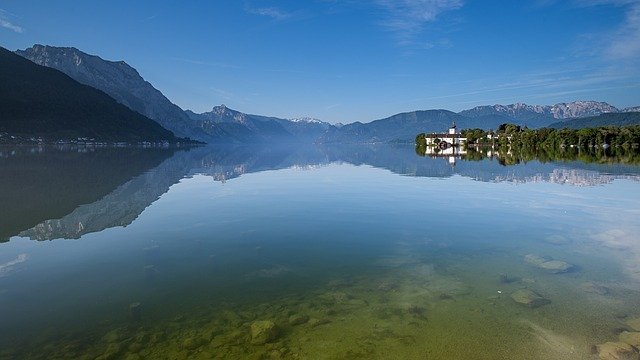Today, I will tell you about Austria and how to plan Austria trip. Austria is a beautiful country in Europe. You will not find a more attractive country than Austria. The one important thing is that it is cheaper than other European countries.
If you plan a trip to Austria, you are in the right place. This site has impressive facts about Austria, making your trip unique.
First of all, it’s Austria. Some people think it is Australia or a part of Australia, but that’s not true. Austria is a sovereign country with an independent government and rules. Its currency is the Euro. Its official language is German. But here, most people speak English, like students and tourists.
Austria is a small country located in central Europe. It is mainly mountainous and landlocked, meaning it has no ocean. It borders countries like Germany, the Czech Republic, and Slovakia to the north, Hungary and Slovenia to the south, and Italy and Switzerland to the west.
Vienna is the capital and largest city in Austria. The total population of Austria is about 9 million, 2 million of which are in Vienna. Austria is a very calm and peaceful Country.

Best Things to Do in Austria
1. Vienna, The Coffee Capital
Vienna is a city where history and modern architecture coexist in harmony. Its unique blend is simply enchanting. It’s a city filled with wonders waiting to be explored. So, are you ready to delve into the city’s charm?
Vienna is the most famous city in the world, and the quality of life there is high. It’s also called the world’s Coffee Capital and home to the world’s most famous Chocolate cake. Vienna has a variety of chocolates that you never find anywhere else.
Vienna has many palaces and more than 100 museums, but today, we will explore three main palaces and museums.

1. The Grand Schönbrunn Palace:
The Schönbrunn Palace is a symbol of the Habsburg monarchy’s Grandeur. The word Schönbrunn, meaning in English, is (beautiful Spring).
This is one of the most important cultural monuments in Austria and one of the major tourist attractions in Vienna. The palace was the primary summer residence of the Habsburg rulers and is renowned for its baroque architecture and elaborate gardens.
Schönbrunn Palace and its gardens were designated a UNESCO World Heritage Site in 1996, recognizing their cultural, historical, and architectural significance.
2. St, Stephens Cathedral:
It is a gothic masterpiece with stunning stained glass windows. The cathedral was initially built in 1137 and has undergone several reconstructions and expansions.
The current Gothic structure was completed mainly in the 14th and 15th centuries. It has been a significant religious and cultural symbol for Vienna throughout history.
The cathedral’s interior is equally remarkable, with beautiful altars, chapels, and artworks. The High Altar was completed in 1647.
Visitors to St. Stephen’s Cathedral can explore its main areas, including the catacombs, where the remains of past bishops and archbishops are interred.
Guided tours are available, providing insights into the cathedral’s history, architecture, and cultural significance.
3. The Parliament Building:
The Austrian Parliament Building in Vienna is one of the city’s most significant and architecturally impressive structures.
The Parliament Building was designed by Theophil Hansen, an influential Danish architect, and constructed between 1874 and 1883.
The Parliament Building houses the two chambers of the Austrian legislature: the National Council (Nationalrat) and the Federal Council (Bundesrat). It is where the country’s laws are debated and enacted, making it the center of Austria’s political life.
The Parliament Building is open to the public for guided tours, which offer insights into its architectural beauty, historical significance, and legislative process. Visitors are not allowed to videograph but can take pictures.
The school trip comes here so students can learn about their leaders and, in the future, become good human beings and good leaders.

2. Salzburg
City in Austria
Salzburg is a beautiful city in Austria near the German border. It is located on the Salzach River’s bank and offers a spectacular view of the eastern Alps.
The beauty of a picture-perfect old town, a hilltop medieval stronghold, and breathtaking alpine scenery will mesmerize visitors.
Salzburg is 281 km northwest of Slovenia, 150 km east of Munich, and 300 km west of Vienna.
It has a humid continental climate with significant seasonal temperature changes and is in the temperate zone.
Due to its architectural and historical richness and unique blend of stunning Alpine surroundings, it is one of the most attractive towns in the world.
Salzburg is renowned for its cultural scene. The Salzburg Festival, held annually, is one of the world’s most reputable music and drama festivals, attracting visitors from all over.
The historic center of Salzburg was designated a UNESCO World Heritage Site in 1997, recognizing its outstanding cultural and architectural value.
3. Salzkammergut:
Area in Austria
Salzkammergut is located in the most beautiful part of Austria and stretches from Salzburg to the Dachstein mountain peak. It is full of lovely, untouched places, including rolling hills, glimmering lakes, Alpine valleys, and majestic mountain ranges.
People visit this beautiful, sparsely populated location to explore charming lakesides and enjoy fishing, boating, hiking, and mountain biking. Due to this spellbinding setting, it is often called the Pearl of Austria.
A small fairytale town, Hallstatt is one of the best places to visit in the Salzkammergut.
The natural beauty of Salzkammergut is breathtaking, with lush green valleys, crystal-clear lakes, and alpine landscapes. It has inspired many artists and writers over the centuries.
Other notable attractions in the region include Hallstatt, the town of St. Wolfgang, the Schafberg Railway, which offers panoramic views, and the Kaiservilla in Bad Ischl
Salzkammergut’s blend of natural beauty, outdoor activities, and cultural heritage makes it a popular destination for tourists seeking relaxation and adventure.

4. Innsbruck
City in Austria
Innsbruck is the capital of Tyrol in western Austria. It is situated on the Bank of the Inn River, one of the most stunning natural settings, surrounded by 2000-meter-high mountains.
Innsbruck has a great mix of history, culture, and architecture. Beautiful historical buildings, including the Baroque St Jacob Cathedral and the Renaissance-style Habsburg imperial palace, are scattered throughout the Medieval old town from the 16th century.
The town has brilliant hiking trails and skiing spots, and you can have a Nordkettenbahnen cable car tour to the top of the north of the beautiful Nordkette mountain.
The city hosts several annual events, including the Innsbruck Christmas Market, the Four Hills Tournament, and the Festival of Early Music.
Innsbruck’s unique combination of historical charm, cultural richness, and outdoor activities makes it a popular destination for tourists year-round.
5. Zell am See
Town in Austria
Zell am See is a small city on the shores of a vibrant blue lake. The picture postcard Zell am See is in an idyllic valley among the stunning Kitzbuhel Alps.
The town is so pretty, with flower-filled meadows and coated slopes. During winter, skiers and snowboarders visit this beautiful site, and hiking, cycling, and water sports are famous in the summer.
The charming and calm Zell am See is worth exploring all year round.
One of the town’s main attractions is crystal-clear Lake Zell. It offers a variety of water activities, such as swimming, sailing, boating, and fishing. In the winter, the lake sometimes freezes over, providing opportunities for ice skating.
Zell am See hosts several events and festivals throughout the year, including the Zell Summer Night Festival and traditional Austrian festivals that showcase local culture and cuisine.
Zell am See’s stunning natural beauty, outdoor activities, and alpine charm make it a favorite destination for visitors seeking adventure and relaxation.
Visa Requirements: How to plan Austria trip
Traveling to Austria from any country involves several steps, including planning your itinerary, booking flights, and understanding entry requirements.
Passport and Visa:
Passport: Ensure your passport is valid for at least six months beyond your planned departure date from Austria.
Visa: Check if you need a visa to enter Austria. Citizens of many countries can enter Austria visa-free for short stays (up to 90 days) for tourism or business purposes. If a visa is required, apply at your country’s Austrian embassy or consulate.
Flights:
Airlines: Austrian Airlines, Lufthansa, British Airways, Emirates, and Qatar Airways frequently fly to Austria.
Travel Insurance: Purchase travel insurance that covers health, accidents, and trip cancellations. It is essential for international travel.
Transportation in Austria:
Public Transport: Austria has an efficient public transport system, including trains, buses, and trams. The ÖBB (Austrian Federal Railways) operates an extensive network connecting major cities and towns.
Austria’s transport system is better and cheaper than other European countries. A full day’s ticket costs only 12 Euro.
It’s a three-hour journey from Vienna to Salzburg. You can see beautiful places and scenery from your train window during this journey.
These trains are very comfortable, they have Wifi and elegant services.
Cost:
Schengen visa cost:

The cost of a Schengen visa for a couple is around Rs 20k. Your trip and ticket will cost 80k. For decent hotels, you have to consider 6k. If you stay six nights, the cost will be 36k + 2k city taxes, 38k.
In Europe, meals are much more expensive, so you have to add 20k for food.
On transportation, you have to spend 32k. Other expenses are around 7k.
The total cost of this entire couple’s trip is 2 lac.
All rates are for travelers from India or Pakistan. If you travel from another country, please confirm these rates with your currency.
Pro Travel Tips:
- Plan and research destinations.
- Use Austria’s efficient public transport.
- Buy a transport pass for savings.
- Learn basic German phrases.
- Explore beyond Vienna.
- Enjoy seasonal activities (skiing in winter, hiking in summer).
- Follow cultural etiquette (politeness, punctuality).
- Try local cuisine (Wiener Schnitzel, Sachertorte).
- Stay hydrated with tap water.
- Respect nature (follow guidelines, don’t litter).
- Consider museum passes for savings.
- Be prepared for changing weather (pack layers).
- Carry some cash; ATMs are widely available.
- Tip appropriately (round up or 5-10% in restaurants).
- Stay aware of your surroundings for safety.
The best time to visit Austria
Spring (March to May)
Mild weather, blooming flowers, fewer tourists, and lower prices
Summer (June to August)
There is warm weather, long daylight hours, and a wide range of outdoor activities, such as hiking, biking, swimming in lakes, and attending music festivals.
Fall (September to November)
Mild weather, beautiful fall foliage, fewer crowds, and harvest festivals.
Winter (December to February)
Snow-covered landscapes, festive Christmas markets, and excellent winter sports.
Choose the time best suits your interests and activities to maximize your trip to Austria.











5 Responses
Heya i’m for the first time here. I found this board and I find It truly useful & it helped me out a lot. I hope to give something back and aid others like you aided me.
Excellent web site. A lot of useful information here. I am sending it to several buddies ans additionally sharing in delicious. And certainly, thank you on your sweat!